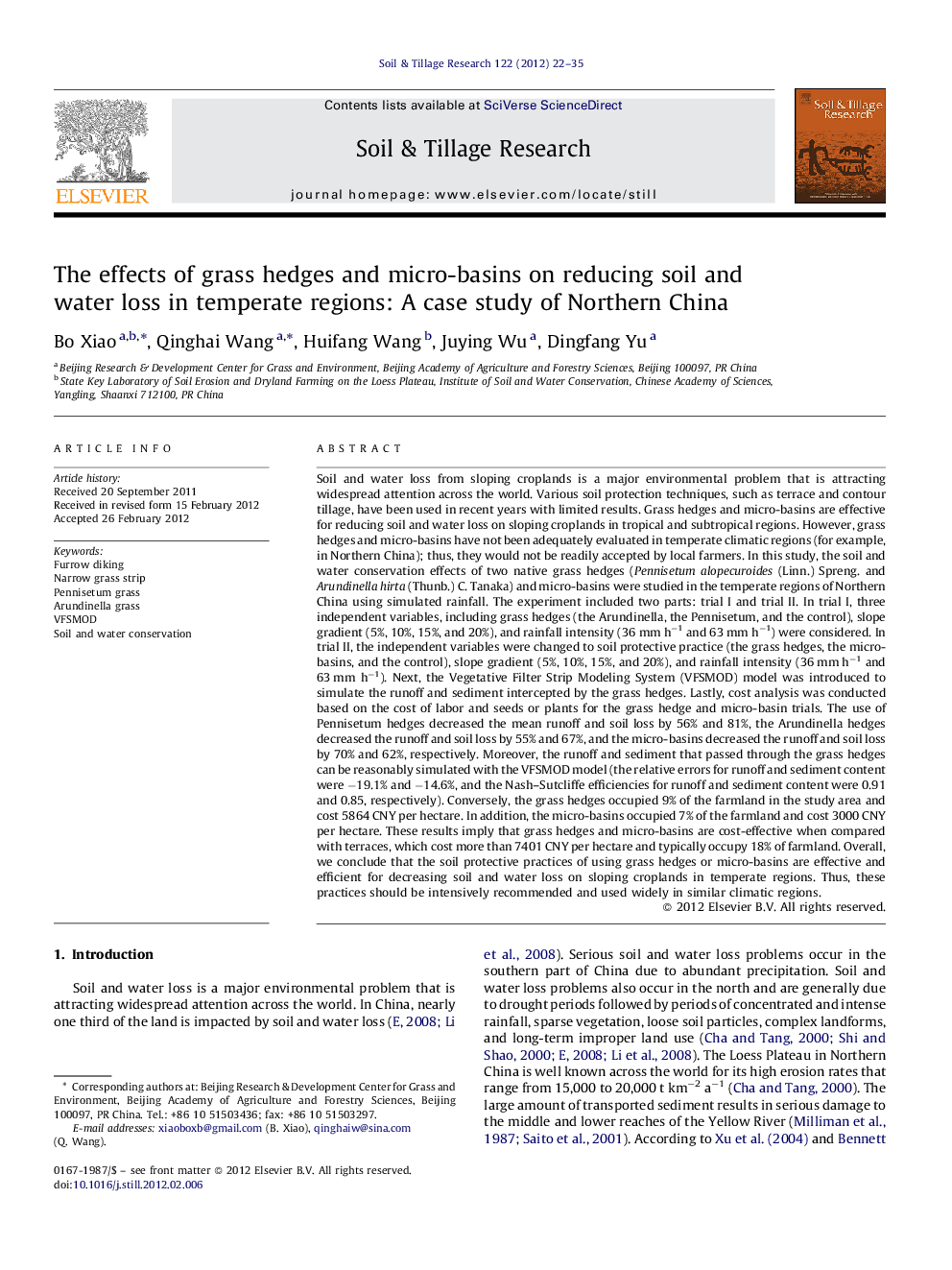| کد مقاله | کد نشریه | سال انتشار | مقاله انگلیسی | نسخه تمام متن |
|---|---|---|---|---|
| 306012 | 513066 | 2012 | 14 صفحه PDF | دانلود رایگان |

Soil and water loss from sloping croplands is a major environmental problem that is attracting widespread attention across the world. Various soil protection techniques, such as terrace and contour tillage, have been used in recent years with limited results. Grass hedges and micro-basins are effective for reducing soil and water loss on sloping croplands in tropical and subtropical regions. However, grass hedges and micro-basins have not been adequately evaluated in temperate climatic regions (for example, in Northern China); thus, they would not be readily accepted by local farmers. In this study, the soil and water conservation effects of two native grass hedges (Pennisetum alopecuroides (Linn.) Spreng. and Arundinella hirta (Thunb.) C. Tanaka) and micro-basins were studied in the temperate regions of Northern China using simulated rainfall. The experiment included two parts: trial I and trial II. In trial I, three independent variables, including grass hedges (the Arundinella, the Pennisetum, and the control), slope gradient (5%, 10%, 15%, and 20%), and rainfall intensity (36 mm h−1 and 63 mm h−1) were considered. In trial II, the independent variables were changed to soil protective practice (the grass hedges, the micro-basins, and the control), slope gradient (5%, 10%, 15%, and 20%), and rainfall intensity (36 mm h−1 and 63 mm h−1). Next, the Vegetative Filter Strip Modeling System (VFSMOD) model was introduced to simulate the runoff and sediment intercepted by the grass hedges. Lastly, cost analysis was conducted based on the cost of labor and seeds or plants for the grass hedge and micro-basin trials. The use of Pennisetum hedges decreased the mean runoff and soil loss by 56% and 81%, the Arundinella hedges decreased the runoff and soil loss by 55% and 67%, and the micro-basins decreased the runoff and soil loss by 70% and 62%, respectively. Moreover, the runoff and sediment that passed through the grass hedges can be reasonably simulated with the VFSMOD model (the relative errors for runoff and sediment content were −19.1% and −14.6%, and the Nash–Sutcliffe efficiencies for runoff and sediment content were 0.91 and 0.85, respectively). Conversely, the grass hedges occupied 9% of the farmland in the study area and cost 5864 CNY per hectare. In addition, the micro-basins occupied 7% of the farmland and cost 3000 CNY per hectare. These results imply that grass hedges and micro-basins are cost-effective when compared with terraces, which cost more than 7401 CNY per hectare and typically occupy 18% of farmland. Overall, we conclude that the soil protective practices of using grass hedges or micro-basins are effective and efficient for decreasing soil and water loss on sloping croplands in temperate regions. Thus, these practices should be intensively recommended and used widely in similar climatic regions.
► Both grass hedges and micro-basins are very effective in reducing soil and water loss.
► The VFSMOD model can be reasonably used to predict the performance of grass hedges.
► The grass hedges occupied 9% of farmland and cost 5864 CNY per hectare.
► The micro-basins occupied 7% of farmland and cost 3000 CNY per hectare.
► The performance of grass hedges and micro-basins decreased with slope gradient and rainfall intensity.
Journal: Soil and Tillage Research - Volume 122, June 2012, Pages 22–35